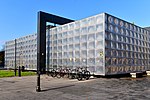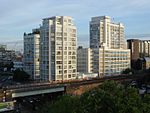Corsica Studios
Corsica Studios is a mid-size multi-function music and arts venue located in Elephant and Castle, London. It was founded in 2002 to provide a space for underground music events, exhibitions, performances and other creative projects and now focuses on DJ and club nights. It consists of two rooms situated within railway arches near Elephant & Castle station. and is known for its stripped-back interior, intimate atmosphere and high-quality sound system. Long-running club nights based at the venue include Trouble Vision and Jaded. Many UK and international artists have also played live at the venue, including Sunn O))) and Four Tet, Underground and experimental gig promoter Baba Yaga's Hut also has a long-term base at Corsica Studios.
Excerpt from the Wikipedia article Corsica Studios (License: CC BY-SA 3.0, Authors).Corsica Studios
Elephant Road, London Elephant and Castle (London Borough of Southwark)
Geographical coordinates (GPS) Address Phone number Website External links Nearby Places Show on map
Geographical coordinates (GPS)
| Latitude | Longitude |
|---|---|
| N 51.49349 ° | E -0.09877 ° |
Address
Corsica Studios
Elephant Road 4/5
SE17 1LB London, Elephant and Castle (London Borough of Southwark)
England, United Kingdom
Open on Google Maps









